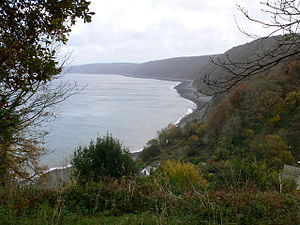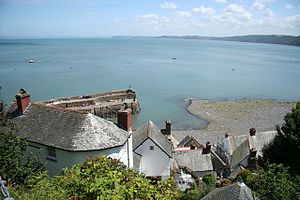Bideford Bay


Bideford Bay, also known as Barnstaple Bay is a large bay on the northwest coast of Devon, at the southwestern end of the Bristol Channel. The bay extends from Hartland Point in the southwest to Morte Point in the northeast, a distance of 14 miles, and is partly sheltered by the island of Lundy, 12 miles offshore. It takes its alternative names from the towns of Bideford and Barnstaple, respectively on the rivers Torridge and Taw which flow into the bay.
Geography
The northern section of the bay's coast comprises the popular surfing and tourist venues of Croyde Bay and Morte Bay (including Woolacombe), smaller bays with beaches set between the steeply sloping headlands of Saunton Down, Baggy Point and Morte Point. The coastline between Saunton Sands and Baggy Point includes cliffs rising in places to 200 feet, comprising Devonian sandstones, shales, slates and limestones, many of which show dramatic folding. Raised beaches hold large erratic boulders transported to the area by glaciation, including a 12-ton pink granite boulder at Saunton thought to have originated in the western Highlands.[1]
The north-facing coastline east of Hartland Point is backed by steep wooded or rocky cliffs with no natural harbours; this section is sparsely populated. The small former fishing village of Clovelly is a popular tourist destination, with a man-made harbour. Further east is the village of Westward Ho!, where there is a clearly defined raised beach platform, cut well above the level of the present beach by wave action at times of high sea levels. There is a submerged forest with peat deposits at the southern end of Westward Ho! Beach, providing evidence of sea level rise which swamped the coastal forest about 6,000 years ago.[1]
North of Westward Ho! the coastline changes to one of extensive sandy beaches backed by sand dune systems. The combined estuary of the rivers Taw and Torridge emerges into the bay between the dune systems of Northam Burrows and Braunton Burrows. The Northam Burrows area is managed as a country park, and comprises a grassy coastal plain with a shingle ridge and spit formed by a process of longshore drift. Braunton Burrows is one of the largest sand dune systems in Britain,[2] at over 3 miles long and a mile wide, and backs the long wide sandy beach of Saunton Sands. The dunes are of international importance for their wildlife, including a number of rarities, and form the core of a "Biosphere Reserve".[1]
Designations and amenities
The coastal landscape of the bay forms the core of the North Devon Area of Outstanding Natural Beauty, a designation which also includes sections of the Devon coast to the east and west.[3] In addition the larger part of this coast has also been designated as a part of the "North Devon and Hartland Heritage Coasts".[4]
A popular long-distance footpath, the South West Coast Path, runs the entire length of the bay. There are car parks for visitors at Croyde, Saunton, Braunton Burrows, Northam Burrows, Westward Ho! and Clovelly.